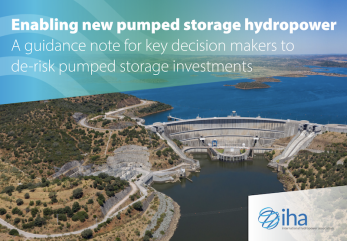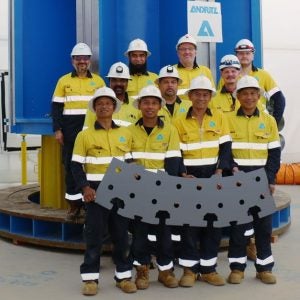
A new guide aimed at reducing investment risks in pumped storage hydropower (PSH) projects was released today. The guide, titled “Enabling New Pumped Storage Hydropower: A guidance note for decision makers to de-risk investments in pumped storage hydropower,” offers recommendations to help key decision-makers navigate the development and financing of PSH projects.
Pumped storage hydropower is the largest form of renewable energy storage, with nearly 200GW of installed capacity worldwide, providing over 90% of all long-duration energy storage. With over 400 projects currently in operation, PSH plays a crucial role in supporting the global shift toward renewable energy.
The guidance note, developed by a working group chaired by Bechtel Corporation and supported by the International Hydropower Association (IHA), aims to enhance project development and delivery by providing tools for effective risk management and financial strategies.
IHA President Malcolm Turnbull highlighted the importance of long-duration energy storage, stating: “The failure to adequately focus on this need for long duration electricity storage is the ignored crisis within the energy crisis. PSH has the unique capacity to resolve this challenge at huge scale, well beyond the reach of even the largest batteries. Pumped hydro systems can also provide inertia and grid stability without reliance on fossil fuels. The recommendations within this guidance note set a course for delivering the energy storage solution the world needs. Policymakers and the industry need to act on these recommendations now to be in with a chance of meeting net zero goals by 2050.”
Chris McMonagle, Global Business Development Manager at Bechtel and Working Group Chairman, emphasized the efficiency and reliability of PSH. He commented: “It is impossible to achieve an efficient, reliable, net zero power grid without combining renewables with large-scale, long duration energy storage. PSH, sometimes known as ‘Rechargeable Water Batteries,’ is the most abundant, proven, and efficient form of long-duration energy storage. This new guidance note seeks to explore how the PSH market can make improvements to the development process and ensure reliability and confidence in delivering projects. It is the result of excellent analysis, healthy debate, and open sharing of industry best practice.”
Key principles outlined in the guide include:
- Private Sector Delivery, Public Sector Enablement: Success in liberalized electricity markets depends on government recognition of the need for storage, support mechanisms, and long-term revenue visibility.
- Investment in Project Development: Early investment and focus from an experienced delivery team increase the chances of project success.
- Good Project Management Equals Good Risk Management: Coordinated teams are essential for mitigating interface risks.
- Optimal Delivery and Commercial Models: Effective risk allocation is vital, with risks minimized by those best placed to manage them and residual risks shared by those able to bear them.
Working group members include Brookfield Renewables, European Investment Bank, British Hydropower Association, GE Vernova, Stantec, KPMG, Mott Macdonald, World Bank Group, Queensland Hydro, Dentons LLP, and the University of Cambridge.
Comments from industry on pumped storage hydropower
Donald Erpenbeck, Vice President & Global Sector Leader for Dams & Hydropower at Stantec, shared his experience, stating: “I have been working on PSH projects for over 35 years both for new construction and refurbishments and have seen many more projects fail in the process than I have seen succeed. I continue to be surprised by experts/owners who oversimplify PSH and/or developers/owners who take PSH for granted in the Energy Transition mix. PSH is one of the most technically difficult projects in the heavy civil works world due to two-way water and power flow combined with tunnelling and dams on the top of mountain and if you magnify those by the scale of high head and long/large tunnels you have a challenge not to be minimized. The only thing more complicated than the technical is the financial/commercial aspects as PSH are long duration energy storage and have little relationship to conventional hydro for modelling the economics and usage. PSH is more a transmission/grids level asset than a generating asset and the companies that own and operate them struggle to model them, they just know they need them, and they make money. It is my hope that the guides produced by this group will increase the success rate of PSH projects in the development cycle and bring more projects to financial close in a more streamlined manner.”
Joaquín Jiménez Labadie, Global Head of Dams & Marine Works at Acciona, noted the guide’s potential to foster collaboration, saying: “I take this initiative as a great opportunity to bring closer different parties and exchange thoughts on how to approach pumped hydro projects, addressing the main issues of these projects in order to create an industry guidance and promote sustainable pumped storage development. Developing a pumped storage hydro project involves navigating a complex web of contracts, licenses, and permits. Effective management of these aspects is crucial for securing funding, ensuring regulatory compliance, and achieving project success. Careful planning, stakeholder engagement, and rigorous adherence to regulations can help mitigate risks and facilitate smooth project execution. The guidance note will serve as a comprehensive reference for informed decision-making, fostering collaboration among stakeholders in the pumped hydro sector.”
Judith Plummer Braeckman, CISL Fellow at the University of Cambridge Institute for Sustainability Leadership, emphasized the financial challenges, stating: “The guidance note raises, amongst others, the key risk to pumped storage hydropower is the difficulty in establishing a firm (bankable) revenue forecast in the absence of government support and regulation or a clear market mechanism. Overcoming this risk is key to unlocking the power of pump storage to support the grid in absorbing large amounts of variable renewable energy.”
Kate Gilmartin, CEO of the British Hydropower Association, highlighted the importance of storage, saying: “Fossil fuels have historically been easy to store and have given us the ability to provide rapid ramp up and ramp down. As we look to decarbonize the world’s power system with renewable energy, we have a long way to go to fill this fundamental requirement of storage and flexibility. Pumped Storage Hydropower will be essential, and the guidance note is a key document to help policy makers translate this necessary technology from concept to deliverable projects.”
Michael Morgenroth, Senior Principal of Hydropower & Dams at Stantec Canada, expressed enthusiasm for international collaboration: “I’ve been working in the hydropower industry and am always interested in sharing insights about challenges and solutions with a global host of experts. Besides several project planning studies, I led a national report on the potential of pumped storage in Canada. There has been no recent project implemented here, so I’m excited to take all the knowledge about international project planning and execution that I’ve gained from the working group home with me.”
Roddy Cormack, Senior Associate at Dentons, remarked on the significance of long-duration energy storage: “Long duration energy storage and pumped storage hydropower in particular is pivotal in terms of giving our electricity grids the stability and flexibility they need to transition to forms of renewable generation and the achievement of net zero goals. Playing a role in the guidance of industry and policy decision makers to assist such projects get through FID and beyond at such a crucial time for our planet has been an enormous honour. The guidance note doesn’t provide all answers for all projects because each PSH project is unique. It does, however, set out what the key questions are making decision makers aware of the issues they need to consider and find solutions for drawing on the examples of best practice we have provided. Stimulating consideration of the key issues early will give decision makers more confidence in progressing projects beyond the drawing boards. It is crucial that business and financial models used in decision making recognize the importance of PSH schemes in the stabilizing of grids increasingly reliant upon variable renewable energy generation. The overall value of PSH involves both generation and storage elements and the policy and regulatory frameworks such schemes sit in may need to flex to recognize both aspects to make such schemes economically viable – otherwise such vital projects may never get passed FID stage.”






